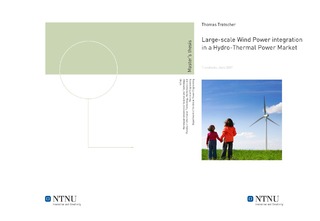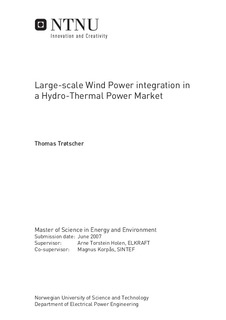| dc.description.abstract | This master thesis describes a quadratic programming model used to calculate the spot prices in an efficient multi-area power market. The model has been adapted to Northern Europe, with focus on Denmark West and the integration of large quantities of wind power. In the model, demand and supply of electricity are equated, at an hourly time resolution, to find the spot price in each area. Historical load values are used to represent demand which is assumed to be completely inelastic. Supply is modeled according to the type of generation: Thermal generators are represented by piecewise linear, upward sloping, marginal cost curves. Historical wind generation data is used to model the fluctuating wind power output, and wind power is considered to have zero marginal cost. Hydro power is modeled by one aggregate reservoir for Norway and one for Sweden; the marginal cost of hydro power is set as a function of the difference between the reservoir level and the historical median reservoir level. Additionally, decentral combined heat and power plants in Denmark are considered to operate irrespective of the market. Six separate price areas constitute the model: Denmark West, Denmark East, Norway, Sweden/Finland, Germany, and Central Europe. The areas are modeled as having no internal bottlenecks and are connected by tie-lines constrained by active power limits. This report quantifies the impact the installed wind power capacity has on the power price in Denmark West by scaling up the wind power output in the model. Because wind power has a marginal cost close to zero, it will force prices down. The effect will be most prominent during high wind speed hours in a power system with substantial amounts of wind power. Results show that the impact is modest; average power prices fall by only 10% if the installed wind power capacity is doubled, and thermal generation will set the power price in all hours until wind energy exceeds 50% of domestic demand in Denmark. Since prices fall the most during hours with high wind power output, income to wind turbine owners will decline quickly as the installed capacity becomes large. The effect is most pronounced at wind energy shares above 40%, thereafter the income -- per MWh sold -- falls rapidly. In absence of government subventions, this effect will limit the economically viable level of installed wind power capacity. Expansion of the cross-border transmission capacity and higher thermal generation costs can both help offset the income reduction to wind turbine owners from higher wind power penetration. Alone, a 30% increase in thermal generation costs can allow 50% of wind energy and still retain todays income to wind turbine owners. Use of the Norwegian hydro reservoirs to balance out fluctuations in wind power output is found to stabilize and reduce the price. This benefits both consumers and wind turbine owners in Denmark. Expansion of transmission capacity to Norway will further stabilize the price; a new 1000MW cable lets the Danish market easily accomodate 50% wind energy. With lower and more volatile prices as a result of high wind power penetration, a load can profit by being flexible. Water electrolysis is one such load; it uses electricity to produce hydrogen, and production can quickly be ramped up and down in accordance with the power price. Presently, steam methane reforming is the least expensive method of producing hydrogen, but with higher wind power penetration, electrolysis might become competitive. Using a previously developed model to assess the cost of electrolysis, in combination with the power market model developed here, this report finds that wind energy must exceed 85% of domestic demand in Denmark, combined with higher natural gas prices, for electrolysis to break even with steam methane reforming. | nb_NO |

